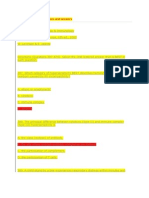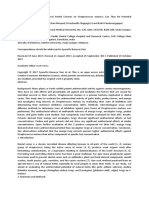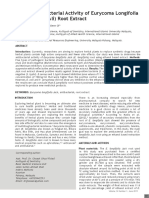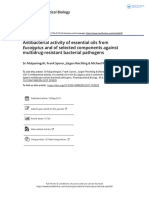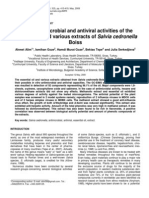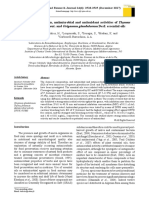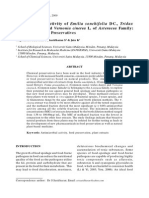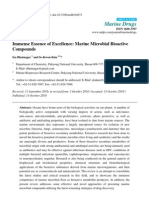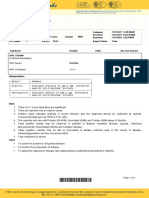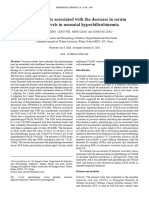Thymus Vulgaris and Eucalyptus Globulus
Thymus Vulgaris and Eucalyptus Globulus
Uploaded by
10sgCopyright:
Available Formats
Thymus Vulgaris and Eucalyptus Globulus
Thymus Vulgaris and Eucalyptus Globulus
Uploaded by
10sgOriginal Title
Copyright
Available Formats
Share this document
Did you find this document useful?
Is this content inappropriate?
Copyright:
Available Formats
Thymus Vulgaris and Eucalyptus Globulus
Thymus Vulgaris and Eucalyptus Globulus
Uploaded by
10sgCopyright:
Available Formats
The Open Microbiology Journal, 2012, 6, 65-69
65
Open Access
Anti-Helicobacter Pylori Activities of Shoya Powder and Essential Oils of Thymus Vulgaris and Eucalyptus Globulus
D. Esmaeili*,1, A. Mohabati Mobarez2 and A. Tohidpour2
1 2
Applied Microbiology Research Center and Department of Medical Microbiology, Bqiyatallah University, Tehran, Iran Department of Bacteriology, Faculty of Medical Sciences, Tarbiat Modares University, Tehran, Iran
Abstract: Background: Helicobacter pylori, an infective agent of more than 50% of the world population is prominent to be the main causative factor in the etiologies of chronic, active or type B gastritis, peptic and duodenal ulcer, gastric carcinoma, and mucosa-associated lymphoid tumors. A high prevalence of this bacterium in dental plaque is always reported. Pharmacological treatment of H. pylori infections includes administration of 3-fold therapeutic regimens which are typically used to suppress H. pylori activity. However, antibiotic resistance frequently develops as a consequence of such treatment. Thus, searching for alternative therapies for H. pylori infections is of special interest. Materials and Methods: In this study, anti H. pylori activities of a traditional antimicrobial drug so-called Shoya and also essential oils of Thymus vulgaris and Eucalyptus globulus were investigated using antimicrobial analysis and serological screening methods. Results: The agar dilution method results revealed the Shoya with the highest inhibitory effect against H. pylori. Also serological screening on tested mice showed a significant effect of this drug in lowering the sera amount of anti H. pylori specific IgA and IgG titers. Both of the essential oils showed different degrees of antibacterial effect against H. pylori. Conclusion: The obtained results showed the antibacterial effect of Shoya powder and Essential oils from Thymus vulgaris and Eucalyptus globulus and purposes new therapeutical alternatives to control the H. pylori infection. Additional studies and clinical trials are necessary to approve the use of these data in health care and pharmacopeia systems.
Keywords: Helicobacter pylori, Shoya, Thymus vulgaris, Eucalyptus globulus. INTRODUCTION Helicobacter pylori is an extracellular gram-negative, spiral bacterium, which typically infects 40% of the adult population in developed countries and up to 90% in some developing countries [1, 2]. Chronic gastritis is seen in nearly all individuals, 10-15% of whom will develop peptic ulcer disease or gastric cancer, the second most common cause of cancer mortality worldwide [3]. There is a high prevalence of H. pylori related gastric infections and dental plaque colonization in developing countries [4, 5]. Current therapies for H. pylori are typically based on combination of a proton pump inhibitor and two antibiotics, but drawbacks include patient compliance, antibiotic resistance, and recurrence of infection. Since infection can cause life threatening diseases and therapy is neither 100% effective nor universally available, development of new therapies may be critically necessary [6]. The Shoya powder is a compound of five substances and acts as a strong antimicrobial drug which can be used for treatment of severe and mild infections. Essential oils (EOs)
*Address correspondence to this author at the Applied Microbiology Research Center, and Department of Medical Microbiology, Bqiyatallah University, Tehran, P.O Box. 14111-115, Iran; Tel: 098-21-22289941; Fax: 098-21-26127258; E-mail: esm114@gmail.com
have been shown to possess antibacterial, antifungal, antiviral, insecticidal and antioxidant properties [7-9]. Some oils have been used in food preservation [10], aromatherapy [11] and fragrance industries [12, 13]. Therefore, it is reasonable to expect a variety of plant compounds in these oils with specific as well as general antimicrobial activity and antibiotic potential [14]. Thyme (Thymus vulgaris L.), a member of the Labiateae family, is an aromatic and medicinal plant of increasing importance in horticulture [15, 16]. T. vulgaris, also known as common thyme, has long been used as a source of the essential oil (thyme oil) and other compounds (e.g. thymol, flavanoid, caffeic acid and labiatic acid) derived from the different parts of the plant [17, 18]. The oil was reported to have antimicrobial effect on bacteria and fungi [19-21] carminative and expectorant [17] activities, most of which are mediated by thymol and carvacrol, as the phenolic components of the oil [22]. Eucalyptus is native to Australia. The genus Eucalyptus contains about 600 species. Of all the species, Eucalyptus globulus is the most widely cultivated in subtropical and Mediterranean regions [23]. Essential oils from Eucalyptus species are used in folk medicine and also widely used in modern cosmetics, food, and pharmaceutical industries [24, 25].
1874-2858/12
2012 Bentham Open
66 The Open Microbiology Journal, 2012, Volume 6
Esmaeili et al.
The present study was aimed to investigate the anti H. pylori activities of Shoya and also essential oils of Thymus vulgaris and Eucalyptus globulus. Preparation of Shoya Powder and Essential Oils The Shoya powder suspensions were prepared in 6 dilutions (10-110-6 mg/ ml) using distilled water as the solvent. The herbs of T. vulgaris (garden Thyme) and the leaves of E. globulus collected and harvested at full flowering state and were authenticated by Dr. R. Omidbaigi, (Professor of botany at the college of agriculture, Tarbiat Modares University, Tehran, Iran). To isolate the oils, the collected materials of every treatment (90g three times) were subjected to hydrodistillation using a Clevenger type apparatus for 6 hours to produce essential oil according to the method recommended by the European Pharmacia [26]. The oils were dried over anhydrous sodium sulfate and stored in sealed vials at low temperature (4C) before analysis. Bacterial Strain and Culturing Helicobacter pylori ATCC 700392 and Helicobacter pylori clinical isolates were cultured in brucella agar [QUELAB incorporations, Canada. containing: peptone, yeast extract, dextrose, sodium chloride, agar and PH of 7.5 in each liter], plus 5% (v/v) defibrinated sheep blood and 10% (v/v) fetal calf serum. Antimicrobial Analysis The agar dilution method was used as approved by the NCCLS [27] with minor modifications: a series of two fold dilutions was prepared for each of the Thymus and Eucalyptus essential oils as the following: 0.03% (v/v), 0.05% (v/v), 0.07% (v/v) and 0.09% (v/v) in the enriched brucella agar medium. To enhance the essential oil solubility, 0.5% (v/v) of tween-20% was added into agar. The Shoya powder suspensions were prepared in serial dilutions and spread into mediums. Inoculated plates with 5l of H. pylori containing about 5 105 of the microorganism were incubated in a microaerophlic jar system (5% O2, 10% CO2 and 85% N2) at 37C for 72 h and then visible colonies formed on the plates were enumerated. The MIC values were defined as the lowest concentration of Shoya and EOs at which no colony of the test bacteria was detected. Finally, the agar disk diffusion method was used to assess the anti H. pylori activity of Shoya suspensions. 100l of each suspension containing about 108 cells/ ml was spread on enriched brucella agar mediums. Six mm filter papers containing 10-12 l from any of suspensions were placed on agar surface. Inoculated plates were incubated for 72 h as described above and then the inhibition zones were measured in diameters. Each test was repeated as duplicate. Immunization Assay In order to analyze the immunological effect of Shoya powder on antibody production, a group of 20 mice showing very low titers of IgA and IgG (T0) against H. pylori were first challenged orally with H. pylori and evaluated after two weeks to analyze their specific anti H. pylori IgA and IgG titers (T1) in sera using a mouse anti H. pylori IgA and IgG serotyping kit (Roche bichemicals, Germany). These were
then treated orally with the Shoya solution for two weeks and were tested for the final titers (T2) of IgA and IgG to assess the potential therapeutic and eradicative effect of Shoya powder against H. pylori. Analyzing Gastric Tissue Finally, the mice stomachs were dissected by gastrectomy and divided into longitudinal strips to assess the presence of H. pylori using a rapid urease broth test kit (Chemy Enzyme chemicals, Iran). T1a: Titers of specific anti-H. pylori IgA and IgG in tested mice sera before challenging with H. pylori. T2b; Titers of specific anti-H. pylori IgA and IgG in mice sera two weeks after challenging with H. pylori. T3c; final titers of IgA and IgG in mice infected with H. pylori and treated two weeks with Shoya suspension. Antibody levels are shown as Mean SD of ODR per microgram of protein units for anti H.pylori IgG and IgA. RESULTS Antimicrobial Assay The MIC results for three tested compounds are shown in Tables 1 and 2 which show the antibacterial effect of Shoya powder and essential oils of T. vulgaris and E. globulus against H. pylori ATCC 700392 using agar dilution method. Shoya powder exhibited relatively a very high anti H. pylori activity (10-5 mg ml-1) (Table 2). Anti H. pylori activity in T. vulgaris and E. globulus were 10.8 and 46.4 (g/ml) respectively.
Table 1. Antimicrobial Activity of Thymus Vulgaris and Eucalyptus Globulus Essential Oils Serial Dilutions Against H. Pylori ATCC 700392
Eucalyptus Globules (g/ml) 5.8 11.6 23.2 46.4 92.8 + H. pylori Growth Thymus Vulgaris (g/ml) 5.4 10.8 21.2 42.4 84.8
H. Pylori Growth + + +
Table 2.
Antimicrobial Activity of Shoya Powder Suspensions Against H. Pylori ATCC 700392
Visible Growth + Suspension Dilutions (mg/ml) 1/10(10-1) 1/100(10-2) 1/1000(10-3) 1/10000(10-4) 1/100000(10-5) 1/1000000(10-6)
Inhibition Zone (mm) 16 16 15.5 15 14 12
Anti H. Pylori Activity
The Open Microbiology Journal, 2012, Volume 6
67
MATERIALS AND METHODS Immunization Assay The Shoya powder suspension treatments against challenged mice could apparently reduce the specific anti H. pylori IgA and IgG. Table 3 shows the tested mice immunization analysis results obtained during 4 months of screening. Rapid Urease Broth Test This test detects Helicobacter pylori (H. pylori) by finding the presence of urease. Urease is an enzyme produced by H. pylori. Urease broth is a differential medium that tests the ability of an organism to produce an exoenzyme, called urease that hydrolyzes urea to ammonia and carbon dioxide. The broth contains two pH buffers, urea, a very small amount of nutrients for the bacteria, and the pH indicator phenol red. Phenol red turns yellow in an acidic environment and fuchsia in an alkaline environment. If the urea in the broth is degraded and ammonia is produced, an alkaline environment is created, and the media turns pink. DISCUSSION There are problems with current antibacterial treatments against H. pylori such as multidrug resistance, high exTable 3.
penses, drug interventions, poor satisfaction, side effects and their impact on the normal intestinal flora [6] which together highlight the need for alternative therapeutic methods such as traditional medicine. Yuan-Chuen Wang et al reported anti H. pylori activity of Plumbago zylanica L. with MIC of 0.32 to 1.28 mg ml-1 [28]. Cellini et al., reported that the phosphate extract of garlic possesses anti H. pylori activity against 19 strains of H. pylori with MIC ranging from 2-5 mg ml-1 [29]. The anti H. pylori activity of the methanol extract of Myroxylon peruiferum, a medicinal plant of Brazil was 62.5 mg ml-1 [30]. The anti H. pylori effect of 22 micromyctes was studied against one standard strain and 11 clinical isolates of H. pylori. Penicillium ochlochloron and Penicillium funiculosum have been proven as the most active fungi against this microorganism (MIC 3.9 mg ml-1) [31]. Our findings through this research significantly indicate Shoya powder as a potential lead compound of a novel class of H. pylori inhibitors where it shows a very high anti H. pylori effect (MIC 10-6mg ml-1). More ever, it is not toxic, and is widely available as a low price traditional drug compound. Determine the antibodies against H. pylori yields in a relatively simple diagnosis, especially with kits that can be used to perform this method and are now being widely and commercially available [32].
Serological Analysis of Variable Titers of IgA and IgG in Mice Challenged with H. Pylori and Treated with Shoya During 4 Months
T3c(g/ml) T3c T2b(g/ml) T2b IgA 50.27 31.61 81.81 42.20 31.23 32.48 3.51.11 97.40 42.01 3.51.22 42.43 30.75 41.88 41.37 32.17 IgG 210.88 180.97 72.11 71.21 81.29 72.11 60.22 151.15 151.10 161.17 162.11 171.19 111.32 120.86 121.53 IgA 300.12 270.39 350.99 151.11 121.21 131.43 171.65 450.34 190.84 23.50.38 28.51.41 291.32 121.65 141.67 172.22 IgG 31.23 21.11 30.78 40.93 21.24 2.51.78 32.13 42.53 52.36 60.79 50.63 32.16 2.52.32 2.94 21.37
b
T1a(g/ml) T1a IgA 6 1.34 5 1.29 7.5 1.2 8 1.02 3.5 1.48 4 1.11 5 1.42 9 1.63 6.5 .12 7 1.43 9 2.18 4 1.21 2.423 3.5 0.89 3 0.96 1 2 3 4 5 6 7 8 9 10 11 12 13 14 15 Tested Mice
IgG 40.23 21.21 22.13 21.33 20.87 21.12 20.89 30.79 31.26 2.52.01 30.96 31.24 3.5 1.09 2.52.11 2.51.31
a
T1 : Titers of specific anti-H. pylori IgA and IgG in tested mice sera before challenging with H. pylori. T2 ; Titers of specific anti-H. pylori IgA and IgG in mice sera two weeks after challenging with H. pylori. T3c; final titers of IgA and IgG in mice infected with H. pylori and treated two weeks with Shoya suspension. Antibody levels are shown as Mean SD of ODR per microgram of protein units for anti H.pylori IgG and IgA.
68 The Open Microbiology Journal, 2012, Volume 6
Esmaeili et al. [2] [3] [4] [5] [6] [7] [8] Del Giudice G, Covacci A, Telford Jl, Montecucco C, Rappuoli R. The design of vaccines against Helicobacter pylori and their development. Annu Rev Immunol 2001; 19: 523-63. Peek RM Jr, Blaser MJ. Helicobacter pylori and gastrointestinal tract adeno- carcinomas. Nat Rev Cancer 2002; 2: 28-37. Butt AK, Khan AA, Bedi R. Helicobacter pylori in dental plaque of Pakistanis. J Int Acad Periodontol 1999; 1: 78-82 Qureshi H, Ahmed W, Arain G, Syed S, Mehdi I, Alam SE. Correlation of histology, CLO, dental plaque and saliva in patients undergoing upper GI endoscopy. Am J Gastroenterol 1999; 94: 861-2. Lucey DR, Clerici M, Shearer GM. Type 1 and Type 2 cytokine dysregulation in human infectious , neoplastic, and inflammatory disease. Clin Microbiol Rev 1996; 9:532-62. Burt SA. Essential oils: their antibacterial properties and potential applications in foods: a review. Int J Food Microbiol 2004; 94: 223-53. Kordali S, Kotan R, Mavi A, Cakir A, Ala A, Yildirim A. Determination of the chemical composition and antioxidant activity of the essential oil of Artemisia dracunculus and of the antifungal and antibacterial activities of Turkish Artemisia absinthium, Artemisia dracunculus, Artemisia santonicum, and Artemisia spicigera essential oils. J Agric Food Chem 2005; 53: 9452-8. Sylvestre M, Pichette A, Longtin A, Nagau F, Legault J. Essential oil analysis and anticancer activity of leaf essential oil of Croton flavens L. from Guadeloupe. J Ethnopharmacol 2006; 103:99-102. Faid M, Bakhy K, Anchad M, Tantaoui-Elaraki A. Alomondpaste: Physicochemical and microbiological characterizations and preservation with sorbic acid and cinnamon. J Food Prod 1995; 58: 54750. Buttner MP, Willeke K, Grinshpun SA. Sampling and analysis of airborne microorganisms. In: Hurst CJ, Knudsen GR, McInerney MJ, Stetzenbach LD, Walter MV, Eds. Manual of Environmental Microbiology. Washington, DC: ASM Press 1996; pp. 629-40. Van de Braak SAAJ, Leijten GCJJ. Essential oils and oleoresins: A survey in the netherlands and other major markets in the european union. Rotterdam: CBI, Centre for the Promotion of Imports from Developing Countries, 1999; p. 116. Milhau G, Valentin A, Benoit F, et al. In vitro antimicrobial activity of eight essential oils. J Essent Oil Res 1997, 9: 329-33. Darokar MP, Mathur A, Dwivedi S, Bhalla R, Khanuja SPS, Kumar S. Detection of antibacterial activity in the floral petals of some higher plants. Curr Sci 1998; 75:187. Inouye S, Abe S, Yamaguchi H, Asakura M. Comparative study of antimicrobial and cytotoxic effects of selected essential oils by gaseous and solution contacts. Int J Aromather 2003; 13: 33-41. Kurita N, Miyaji M, Kurane V, Takahara Y, Ichimura K. Antifungal activity and molecular orbital energies of aldehyde compounds fom oils of higher plants. Agric Biol Chem 1979; 43: 2365-71. Leung AY, Foster S. Encyclopedia of common natural ingredients used in food, drugs, and cosmetics. New York: John Wiley & Sons 1996; pp. 222-4. Al-Shuneigat J, Cox SD, Markham JL. Effects of a topical essential oil-containing formulation on biofilm-forming coagulase-negative staphylococci. Lett Appl Microbiol 2005, 41: 52-5. De Bouchberg MS, Allegrini J, Bessiere C, Attisto M, Passet J, Granger R. Properties microbiologiques de bciles essentielles de chimotypes de Thymus vulgaris Linnaeus. Rivista Italiana Essenza Profumi Piante Officinai Aromi Sapingi Cosmetici 1976; 58: 52736. Horne D, Holm M, Oberg C, Chao S, Young PG . Antimicrobial effects of essential oils on Streptococcus pneumonia. J Essent Oil Res 2001; 13: 387-92 Chao SC, Young DG, Oberg C. Screening for inhibitory activity of essential oils on selected bacteria, fungi and viruses. J Essent Oil Res 2000;12 : 639-49. Meister A, Bernhardt G, Christoffel V, Buschauer A. Antispasmodic activity of Thymus vulgaris extract on the isolated guineapig trachea: discrimination between drug and ethanol effects. Planta Med 1999 65: 512-6. Gray AM, Flatt PR. Anti-hyperglycemic actions of Eucalyptus globulus (eucalyptus) are associated with pancreatic and extrapancreatic effects in mice. J Nutr 1998; 128: 2319-23. Gomes-Carneiro, Felzenszwalb MR, Paumgartten I. Mutagenicity testing (+/)-camphor, 1, 8-cineole, citral, citronellal, ()- menthol and terpineol with the Salmonella/microsome assay. Mutat Res 1998; 416: 129-36.
Evaluating the effect of Shoya powder suspensions on specific antibody production in human and mice cases clearly resulted in a meaningful decrease in titers of specific anti H. pylori IgA and IgG which can be referred to the therapeutic effect of this traditional drug. Essential oils are considered as possible sources of new antimicrobial agents especially against bacterial pathogens [33]. Many studies have investigated the antibacterial activity of essential oils from T. vulgaris and E. globulus against different pathogens [34]. Their antimicrobial activity is mainly attributed to the presence of some active constituents in their EOs together with their hydrophobicity which enables them for rupturing cell membranes and intrastructures [35]. In this study, EOs of T. vulgaris and E. globulus were used to assess their antibacterial activity against H. pylori ATCC 700392 by inserting some minor changes to the NCCLS recommended agar dilution method that have been originally developed for analyzing the conventional antimicrobial agents activity, so it could be used to analyze plant extracts and essential oils for their antimicrobial activity [36]. The obtained results confirm that EO from T. vulgaris showed better inhibitory effect against H. pylori than EO from E. globulus. Previous studies performed in Pakistan [37, 38] India [39], Nigeria [40] and Venezuela [41] indicate positive correlation between oral and gastric H. pylori colonization. It is implicated that oral cavity may be the first colonization site which then infects the gastric mucosa. According to difficulties for eradication of H. pylori Due to the disadvantages of antibacterial treatments and presence of H. pylori in mouth as a secondary reservoir [42] and also the obtained results of this research, it is recommended to combine the triple drug treatment regime with Shoya as a mouth washing solution or as a tooth paste ingredient or together with EOs of T. vulgaris and E. globulus in order to control the H. pylori presence specially for eradication of H. pylori in dental plaques and related diseases. Additional clinical research and trials are necessary to completely confirm the above results for medical purposes. As mentioned above, dental plaques play a critical role as important reservoirs for H. pylori, therefore this bacteria will be able for colonization in dental plaque and inside oral yeasts where is protected from antibacterial drugs effects. In this study using Shoya powder against H. pylori resulted in complete eradication of this bacterium which can be effective enough to reduce the rate of infection transmission from mouth to gastric. CONFLICT OF INTEREST The author(s) confirm that this article content has no conflicts of interest. ACKNOWLEDGEMENT We are so thankful of Dr. Graham (University of Washington, Seattle, Washington. Baylor College of Medicine, Houston, Texas. USA) and Dr. Kuster (the Laboratory of Gastroenterology at the ErasmusMC, Rotterdam, Netherlands) for their warmly granted helps and advices. REFERENCES
[1] Suerbaum S, Michetti P. Helicobacter pylori infection. N Engl J Med 2002; 347:1175-86.
[9] [10]
[11]
[12]
[13] [14] [15] [16] [17] [18] [19]
[20] [21] [22]
[23] [24]
Anti H. Pylori Activity [25] [26] [27] [28] [29] [30] Trigg JK. Evaluation of a eucalyptus-based repellent against Anopheles spp. in Tanzania. J Am Mosq Control Assoc 1996; 12: 243-6. Calamari D, Zuccato E, Castiglioni S, Bagnati R, Fanelli R. Strategic survey of therapeutic drugs in the rivers Po and Lambro in northern Italy. Environ Sci Technol 2003; 37: 1241-8 NCCLs. Methods for dilution antimicrobial susceptibility tests for bacteria that grow aerobically. Approved Standard. 6th ed. NCCLS document M7-A6 2004. Wang Y, Huang T. Anti-Helicobacter pylori activity of PLumbago zeylanica L. FEMS Immunol. Med Microbiol 2005; 43: 407-12. Cellini L, Campli ED, Masulli M, Bartolomeo SD, Allocati N. Inhibition of Helicobacter pylori by garlic extracts (Allium sativum). FEMS Immunol Med Microbiol 1996; 13: 277-9. Ohsaki A, Takashima J, Chiba N, Kawamura M. Microanalaysis of selective potent anti-Helicobacter pylori compound in a Brazilian medicinal plant, Myroxylon peruiferum and the activity of analogues. Bioorg Med Chem Lett 1999; 9:1109-12. Stamatis G, Rancic A, Sokovic M, et al. In vitro inhibition of Helicobacter pylori by Micromycetes. FEMS Immunol Med Microbiol 2005;45: 71-4. Azuma T, Kato T, Hirai M, Ito S, Kohli Y. Diagnosis of Helicobacter pylori infection. J Gastroenterol Hepatol 1996; 11: 662-9. Mitscher LA, Drake S, Gollapudi SR, Okwute SK. A modern look at folkloric use of anti-infective agents. J Nat Prod 1987; 50: 102540. Cimanga K, Kambu K, Tona L, et al. Correlation between chemical composition and antibacterial activity of essential oils of some
The Open Microbiology Journal, 2012, Volume 6
69
[35] [36] [37] [38] [39] [40]
[31] [32] [33] [34]
[41] [42]
aromatic medicinal plants growing in the Democratic Republic of Congo. J Ethnopharmacol 2002; 79: 213-20. Sikkema J, Debont JAM, Poolman B. Interactions of cyclic hydrocarbons with biological membranes. J Biol Chem 1994; 269: 80228. Hammer KA, Carson CF, Riley TV. Antimicrobial activity of essential oils and other plant extracts. J Appl Microbiol 1999; 86: 985-90. Butt AK, Khan AA, Khan AA, Izhar M, Alam A, Shah SW. Correlation of Helicobacter pylori in dental plaque and gastric mucosa of dyspeptic patients. J Pak Med Assoc 2002 ; 52: 196-200. Siddiq M, Rehman H, Mahmood A. Evidence of Helicobacter pylori infection in dental plaque and gastric mucosa. J Coll Physicians Surg Pak 2004; 14: 205-7. Anand PS, Nandakumar K, Shenoy KT. Are dental plaque, poor oral hygiene and periodontal disease associated with Helicobacter pylori infection? J Periodontol 2006; 77: 692-8. Ogunbodede EO, Lawal OO, Lamikanra A, Okeke IN, Rotimi O, Rasheed AA. Helicobacter pylori in the dental plaque and gastric mucosa of dyspeptic Nigerian patients. Trop Gastroenterol 2002; 23: 127-33. Berroteran A, Perrone M, Correnti M, et al. Detection of Helicobacter pylori DNA in the oral cavity and gastroduodenal system of a Venezuelan population. J Med Microbiol 2002; 51: 764-70. Oshowo A, Tunio M, Gillam D, et al. Oral colonization is unlikely to play an important role in Helicobacter pylori infection. Br J Surg 1998; 85: 850-2.
Received: March 04, 2012
Revised: May 05, 2012
Accepted: May 15, 2012
Esmaeili et al.; Licensee Bentham Open. This is an open access article licensed under the terms of the Creative Commons Attribution Non-Commercial License (http://creativecommons.org/licenses/ by-nc/3.0/) which permits unrestricted, non-commercial use, distribution and reproduction in any medium, provided the work is properly cited.
You might also like
- 130 Immunology Questions and AnswersDocument46 pages130 Immunology Questions and Answers成失87% (15)
- F2204052833Document6 pagesF2204052833drbharathshivkumarNo ratings yet
- Assessment of Antimicrobial Activity of Cassia Fistula and Flacoartia Indica Leaves.Document5 pagesAssessment of Antimicrobial Activity of Cassia Fistula and Flacoartia Indica Leaves.Eliana CaraballoNo ratings yet
- 01 Antibacterial Effects of Natural Herbal Extracts On Streptococcus MutansDocument6 pages01 Antibacterial Effects of Natural Herbal Extracts On Streptococcus MutansRia mayaNo ratings yet
- Research Article Staphylococcus AureusDocument11 pagesResearch Article Staphylococcus Aureusshaikhwasif9597No ratings yet
- zhang2018Document7 pageszhang2018fansofmileycyrus.12102001No ratings yet
- Paper 161Document7 pagesPaper 161Bilal SarwarNo ratings yet
- Ajol File Journals - 209 - Articles - 166833 - Submission - Proof - 166833 2485 429725 1 10 20180215Document11 pagesAjol File Journals - 209 - Articles - 166833 - Submission - Proof - 166833 2485 429725 1 10 20180215Grace MarieNo ratings yet
- ANTIMICROBIAL ACTIVITY OF OREGANO (Origanum Vulgare L.) AND BASILDocument6 pagesANTIMICROBIAL ACTIVITY OF OREGANO (Origanum Vulgare L.) AND BASILJaime TerrazoNo ratings yet
- Ayad Et Al - Antibacterial.efficiency - PomeloDocument5 pagesAyad Et Al - Antibacterial.efficiency - PomeloJesus NavaNo ratings yet
- Mith 2014Document14 pagesMith 2014yarach9494No ratings yet
- Antibacterial Activity of Phyto Essential Oils On Flaccherie Causing Bacteria in The Mulberry Silk Worm, B.Mori. LDocument5 pagesAntibacterial Activity of Phyto Essential Oils On Flaccherie Causing Bacteria in The Mulberry Silk Worm, B.Mori. LIOSRjournalNo ratings yet
- Comparison of Antimicrobial Activities of Clove Oil & Its Extract On Some Food Borne MicrobesDocument7 pagesComparison of Antimicrobial Activities of Clove Oil & Its Extract On Some Food Borne MicrobesSeema YadavNo ratings yet
- 11 JHS Antibacterial Efficiency of Pomelo Peel Extract On Various Concentrations Against Selected MicroorganismsDocument4 pages11 JHS Antibacterial Efficiency of Pomelo Peel Extract On Various Concentrations Against Selected MicroorganismsTriesha GervacioNo ratings yet
- Comparative Efficacy of Herbal Essences With Amphotricin B and Ketoconazole On CandidaDocument7 pagesComparative Efficacy of Herbal Essences With Amphotricin B and Ketoconazole On CandidaiisisiisNo ratings yet
- PR 13110Document8 pagesPR 13110RyanNo ratings yet
- Bioactivity of Artemisia Herba Alba Essential Oil Against Plant Pathogenic FungiDocument7 pagesBioactivity of Artemisia Herba Alba Essential Oil Against Plant Pathogenic Fungisunaina agarwalNo ratings yet
- Biochemical, Enzymatic, and Immunological Study On Antimutagenic Achillea Millefolium Methanolic Extract in VivoDocument6 pagesBiochemical, Enzymatic, and Immunological Study On Antimutagenic Achillea Millefolium Methanolic Extract in VivoSabrina JonesNo ratings yet
- IMJM Vol14No1 Page 77-81 in Vitro Antibacterial Activity of Eurycoma Longifolia PDFDocument5 pagesIMJM Vol14No1 Page 77-81 in Vitro Antibacterial Activity of Eurycoma Longifolia PDFENjea LopiSma SPdieNo ratings yet
- Kavitha Et Al PDFDocument5 pagesKavitha Et Al PDFDaris UntoroNo ratings yet
- TMPFB TMPDocument7 pagesTMPFB TMPFrontiersNo ratings yet
- Penting AromadendeDocument8 pagesPenting AromadendeAizhuuaf TurquoiseNo ratings yet
- Article1380380118 - Alim Et AlDocument7 pagesArticle1380380118 - Alim Et AlrenshagullNo ratings yet
- In Vitro Evaluation of The Antibiogramic Activities of The Seeds of Myristica FragransDocument6 pagesIn Vitro Evaluation of The Antibiogramic Activities of The Seeds of Myristica FragransAndry LarsenNo ratings yet
- ) Antibacterial Activity of Ocimum Sanctum ExtractsDocument10 pages) Antibacterial Activity of Ocimum Sanctum ExtractsAlvia Muri PrabowoNo ratings yet
- Anum PHD Paper 2019Document8 pagesAnum PHD Paper 2019Qamar75No ratings yet
- An Invitro Study of Determination of Anti-Bacterial, Antioxidant, Anti-Inflammatory Potential of Piper Betel Essential OilDocument8 pagesAn Invitro Study of Determination of Anti-Bacterial, Antioxidant, Anti-Inflammatory Potential of Piper Betel Essential OilSaiful AbdulNo ratings yet
- ImranDocument39 pagesImranPrashant GuptaNo ratings yet
- WaelMohamedAbuEl WafaandWalaaSaidMohamedAbdEl AllDocument13 pagesWaelMohamedAbuEl WafaandWalaaSaidMohamedAbdEl AllCarl Ritchie TempleNo ratings yet
- Phytochemical Characterization of Pumpkin Seed WithDocument8 pagesPhytochemical Characterization of Pumpkin Seed WithLarisa CatautaNo ratings yet
- In Vitro Antimicrobial Activity of Citrus Aurantifolia and Its Phytochemical ScreeningDocument4 pagesIn Vitro Antimicrobial Activity of Citrus Aurantifolia and Its Phytochemical ScreeningGrace OktaviaNo ratings yet
- Antimicrobial Assay of Stevia Rebaudiana Bertoni Leaf Extracts Against 10 PathogensDocument0 pagesAntimicrobial Assay of Stevia Rebaudiana Bertoni Leaf Extracts Against 10 PathogensNadya PurwantyNo ratings yet
- Sambiiloto Dann Hiv PDFDocument6 pagesSambiiloto Dann Hiv PDFUeki Cinta LingkunganNo ratings yet
- Evaluation of Antibacterial & Antioxidant Activities of The Leaf Essential Oil & Leaf Extracts of Citrus AurantifoliaDocument9 pagesEvaluation of Antibacterial & Antioxidant Activities of The Leaf Essential Oil & Leaf Extracts of Citrus AurantifoliaFirman TirmaNo ratings yet
- Antimicrobial Activity of Essential Oil of Eucalyptus Globulus Against Fish Pathogenic BacteriaDocument4 pagesAntimicrobial Activity of Essential Oil of Eucalyptus Globulus Against Fish Pathogenic BacteriaLaires AraujoNo ratings yet
- Monitoring of Antimicrobial Effect of GC-MS Standardized UropathogensDocument9 pagesMonitoring of Antimicrobial Effect of GC-MS Standardized UropathogensInternational Organization of Scientific Research (IOSR)No ratings yet
- 1 s2.0 S2222180815608386 MainDocument6 pages1 s2.0 S2222180815608386 MainSarah Zielda NajibNo ratings yet
- Salmonella Typhi, Research of "Activity Test of Leaf Salung Bioactive Materials (Psychotria ViridifloraDocument3 pagesSalmonella Typhi, Research of "Activity Test of Leaf Salung Bioactive Materials (Psychotria ViridifloraEdward AndreNo ratings yet
- 172tonutraj WoundDocument4 pages172tonutraj Woundfa_ndriNo ratings yet
- TC 15025Document4 pagesTC 15025MD MuntaharNo ratings yet
- Cerbera Seeds - OpemDocument6 pagesCerbera Seeds - OpemMuhammad NaseerNo ratings yet
- Agar Well Diffusion MTDDocument7 pagesAgar Well Diffusion MTDRoland GealonNo ratings yet
- Chemical Composition Antibacterial Activity and Mechanism of Action of Essential Oil From Seeds of Fennel Foeniculum Vulgare Mill 2014 Food ControlDocument8 pagesChemical Composition Antibacterial Activity and Mechanism of Action of Essential Oil From Seeds of Fennel Foeniculum Vulgare Mill 2014 Food ControlAni IoanaNo ratings yet
- Fontanesii Boiss. Et Reut. and Origanum Glandulosum Desf. Essential OilsDocument8 pagesFontanesii Boiss. Et Reut. and Origanum Glandulosum Desf. Essential OilsBAZNAS Kabupaten MajalengkaNo ratings yet
- Antibacterial and ModulatoryDocument6 pagesAntibacterial and ModulatoryevilbioNo ratings yet
- 1 Malysian Journal FATIMA BOUAZZA 2022Document10 pages1 Malysian Journal FATIMA BOUAZZA 2022Fatima BouazzaNo ratings yet
- Repellency of Essential Oils Extracted From PlantsDocument17 pagesRepellency of Essential Oils Extracted From Plantsantonio louise anjella monNo ratings yet
- The Effect of Seasonal Variation On The Antibacterial Activity of T. Diversifolia Leaf Extracts Against Pathogenic Bacterial StrainsDocument5 pagesThe Effect of Seasonal Variation On The Antibacterial Activity of T. Diversifolia Leaf Extracts Against Pathogenic Bacterial StrainsJorge Alejandro Noriega PimentelNo ratings yet
- 1094 IjirseDocument7 pages1094 Ijirsemohithvishnu64No ratings yet
- Chemrj 2016 01 04 54 58Document5 pagesChemrj 2016 01 04 54 58editor chemrjNo ratings yet
- EJM - Volume 53 - Issue 1 - Pages 49-68Document20 pagesEJM - Volume 53 - Issue 1 - Pages 49-68seema yadavNo ratings yet
- Moringa Antifungal PropertiesDocument5 pagesMoringa Antifungal Propertiesesada11No ratings yet
- EL 2016 Antibacterial Activity of Nanoemulsion of Thymus D EO AgainstDocument25 pagesEL 2016 Antibacterial Activity of Nanoemulsion of Thymus D EO AgainstyasinNo ratings yet
- Research Article (Lavandula Angustifolia) Essential Oil On: Effect of Lavender Acute Inflammatory ResponseDocument10 pagesResearch Article (Lavandula Angustifolia) Essential Oil On: Effect of Lavender Acute Inflammatory ResponseAndreeaNo ratings yet
- Evaluation of The Antimicrobial Activity of Curry Leaves (Murraya Koenigii)Document8 pagesEvaluation of The Antimicrobial Activity of Curry Leaves (Murraya Koenigii)vanshika kelkarNo ratings yet
- Ajol File Journals - 82 - Articles - 82639 - Submission - Proof - 82639 973 198882 1 10 20121025Document8 pagesAjol File Journals - 82 - Articles - 82639 - Submission - Proof - 82639 973 198882 1 10 20121025yarach9494No ratings yet
- 27 Vol9Document6 pages27 Vol9Amine BenineNo ratings yet
- Antimicrobial Activity of Emilia Sonchifolia DC Tridax Procumbens Etc Potential As Food PreservativesDocument9 pagesAntimicrobial Activity of Emilia Sonchifolia DC Tridax Procumbens Etc Potential As Food Preservativessripathy84No ratings yet
- tmp3741 TMPDocument8 pagestmp3741 TMPFrontiersNo ratings yet
- 65 Ess16042Document12 pages65 Ess16042IgnacioNo ratings yet
- Garlic (Allium sativum): Monograph on a herb reputed to be medicinalFrom EverandGarlic (Allium sativum): Monograph on a herb reputed to be medicinalNo ratings yet
- A Research Agenda For Helminth Diseases of Humans: Modelling For Control and EliminationDocument11 pagesA Research Agenda For Helminth Diseases of Humans: Modelling For Control and Elimination10sgNo ratings yet
- Characterization of Three-Dimensional Spatial Aggregation and Association Patterns of Brown Rot Symptoms Within Intensively Mapped Sour Cherry TreesDocument8 pagesCharacterization of Three-Dimensional Spatial Aggregation and Association Patterns of Brown Rot Symptoms Within Intensively Mapped Sour Cherry Trees10sgNo ratings yet
- NIH Public Access: Author ManuscriptDocument16 pagesNIH Public Access: Author Manuscript10sgNo ratings yet
- Sex-Dependent Novelty Response in Neurexin-1 A Mutant MiceDocument6 pagesSex-Dependent Novelty Response in Neurexin-1 A Mutant Mice10sgNo ratings yet
- 1Document8 pages110sgNo ratings yet
- Role of Oxidative Stress and The Activity of Ethylene Biosynthetic Enzymes On The Formation of Spongy Tissue in Alphonso' MangoDocument5 pagesRole of Oxidative Stress and The Activity of Ethylene Biosynthetic Enzymes On The Formation of Spongy Tissue in Alphonso' Mango10sgNo ratings yet
- NIH Public Access: p21 Protects "Super p53" Mice From The Radiation-Induced Gastrointestinal SyndromeDocument7 pagesNIH Public Access: p21 Protects "Super p53" Mice From The Radiation-Induced Gastrointestinal Syndrome10sgNo ratings yet
- Is Axis Position Within Tree Architecture A Determinant of Axis Morphology, Branching, Flowering and Fruiting? An Essay in MangoDocument12 pagesIs Axis Position Within Tree Architecture A Determinant of Axis Morphology, Branching, Flowering and Fruiting? An Essay in Mango10sgNo ratings yet
- Field Attractants For Pachnoda Interrupta Selected by Means of GC-EAD and Single Sensillum ScreeningDocument14 pagesField Attractants For Pachnoda Interrupta Selected by Means of GC-EAD and Single Sensillum Screening10sgNo ratings yet
- Marine Drugs: Immense Essence of Excellence: Marine Microbial Bioactive CompoundsDocument29 pagesMarine Drugs: Immense Essence of Excellence: Marine Microbial Bioactive Compounds10sgNo ratings yet
- Allergy: Hypersensitivity Manifestations To The Fruit MangoDocument7 pagesAllergy: Hypersensitivity Manifestations To The Fruit Mango10sgNo ratings yet
- Limits of Nuclear Ribosomal DNA Internal Transcribed Spacer (ITS) Sequences As Species Barcodes For FungiDocument1 pageLimits of Nuclear Ribosomal DNA Internal Transcribed Spacer (ITS) Sequences As Species Barcodes For Fungi10sgNo ratings yet
- Optimization of Serine Protease Purification From Mango (Mangifera Indica Cv. Chokanan) Peel in Polyethylene Glycol/Dextran Aqueous Two Phase SystemDocument14 pagesOptimization of Serine Protease Purification From Mango (Mangifera Indica Cv. Chokanan) Peel in Polyethylene Glycol/Dextran Aqueous Two Phase System10sgNo ratings yet
- Contrasting Diversity Patterns of Crenarchaeal, Bacterial and Fungal Soil Communities in An Alpine LandscapeDocument7 pagesContrasting Diversity Patterns of Crenarchaeal, Bacterial and Fungal Soil Communities in An Alpine Landscape10sgNo ratings yet
- The History, Fungal Biodiversity, Conservation, and Future Perspectives For Mycology in EgyptDocument20 pagesThe History, Fungal Biodiversity, Conservation, and Future Perspectives For Mycology in Egypt10sgNo ratings yet
- Activation of Ethylene-Responsive P-Hydroxyphenylpyruvate Dioxygenase Leads To Increased Tocopherol Levels During Ripening in MangoDocument11 pagesActivation of Ethylene-Responsive P-Hydroxyphenylpyruvate Dioxygenase Leads To Increased Tocopherol Levels During Ripening in Mango10sgNo ratings yet
- Validation and Application of A PCR Primer Set To Quantify Fungal Communities in The Soil Environment by Real-Time Quantitative PCRDocument13 pagesValidation and Application of A PCR Primer Set To Quantify Fungal Communities in The Soil Environment by Real-Time Quantitative PCR10sgNo ratings yet
- Shifts in Soil Microorganisms in Response To Warming Are Consistent Across A Range of Antarctic EnvironmentsDocument11 pagesShifts in Soil Microorganisms in Response To Warming Are Consistent Across A Range of Antarctic Environments10sgNo ratings yet
- New Strategy For Rapid Diagnosis and Characterization of Fungal Infections: The Example of Corneal ScrapingsDocument10 pagesNew Strategy For Rapid Diagnosis and Characterization of Fungal Infections: The Example of Corneal Scrapings10sgNo ratings yet
- Relationships of Cereal Crops and Other Grasses: Vol. 95, Pp. 2005-2010, March 1998 Colloquium PaperDocument6 pagesRelationships of Cereal Crops and Other Grasses: Vol. 95, Pp. 2005-2010, March 1998 Colloquium Paper10sgNo ratings yet
- Soil Eukaryotic Microorganism Succession As Affected by Continuous Cropping of Peanut - Pathogenic and Beneficial Fungi Were SelectedDocument9 pagesSoil Eukaryotic Microorganism Succession As Affected by Continuous Cropping of Peanut - Pathogenic and Beneficial Fungi Were Selected10sgNo ratings yet
- Evolution and Organization of A Highly Dynamic, Subtelomeric Helicase Gene Family in The Rice Blast Fungus Magnaporthe GriseaDocument10 pagesEvolution and Organization of A Highly Dynamic, Subtelomeric Helicase Gene Family in The Rice Blast Fungus Magnaporthe Grisea10sgNo ratings yet
- Diazotrophicus On Solid Media To Changes in AtmosphericDocument7 pagesDiazotrophicus On Solid Media To Changes in Atmospheric10sgNo ratings yet
- Special Issue Paper: Olorode Afr. J. Trad. CAM (2007) 4 (4) : 532 - 540Document9 pagesSpecial Issue Paper: Olorode Afr. J. Trad. CAM (2007) 4 (4) : 532 - 54010sgNo ratings yet
- Plasma Proteins ImmunoglobulinsDocument71 pagesPlasma Proteins ImmunoglobulinsIdenyi Daniel EwaNo ratings yet
- Hypersensitivity ReactionsDocument12 pagesHypersensitivity Reactionsella Sy100% (1)
- FUNDA 2 Ratio 2023Document16 pagesFUNDA 2 Ratio 2023Danielle Ann ChiongNo ratings yet
- Microbiology and Immunology MobileDocument10 pagesMicrobiology and Immunology MobileViral PatelNo ratings yet
- Antibody Production and Purification Technical Handbook, Version 2Document41 pagesAntibody Production and Purification Technical Handbook, Version 2bh14561No ratings yet
- Ijerph 19 11045Document12 pagesIjerph 19 11045quentutraNo ratings yet
- Wanger A, Chavez V, Huang R, Wahed A, Dasgupta A, Actor J. 2017. Microbiology and Molecular Diagnosis in Pathology. Camridge (US) Academic Press.Document12 pagesWanger A, Chavez V, Huang R, Wahed A, Dasgupta A, Actor J. 2017. Microbiology and Molecular Diagnosis in Pathology. Camridge (US) Academic Press.Annisa YohanesNo ratings yet
- Immulite 1000Document2 pagesImmulite 1000Jahidul MonirNo ratings yet
- Chapter 11 SB025 Answer ImmunityDocument14 pagesChapter 11 SB025 Answer ImmunityANIS IESYAMINA ALYSA ARIFNo ratings yet
- Sars-Cov-2 RBD Neutralizing Antibody Induction Is Enhanced by Particulate VaccinationDocument11 pagesSars-Cov-2 RBD Neutralizing Antibody Induction Is Enhanced by Particulate VaccinationmwdhtirahNo ratings yet
- Brucellosis in Cattle Interim Manual For The Veterinarian & AHT - Sept2016 - SignedDocument54 pagesBrucellosis in Cattle Interim Manual For The Veterinarian & AHT - Sept2016 - SignedSuraj_Subedi100% (3)
- Immunity PDFDocument19 pagesImmunity PDFKirkCuaNo ratings yet
- TARIF PRODIA TAHUN 2019 Rev 2Document9 pagesTARIF PRODIA TAHUN 2019 Rev 2cici100% (1)
- Interpretation: S74 - Healthnet CC Healthnet, Old No.34, New No.12, Besant Avenue Road, Opp To Royalenfield ShowroomDocument2 pagesInterpretation: S74 - Healthnet CC Healthnet, Old No.34, New No.12, Besant Avenue Road, Opp To Royalenfield ShowroomPrabhakaran ArumugamNo ratings yet
- Global Manual Revised 12102015Document124 pagesGlobal Manual Revised 12102015Ishak Abdul GafarNo ratings yet
- Paper BSC (Medical Laboratory Technologist) ImmunologyDocument5 pagesPaper BSC (Medical Laboratory Technologist) ImmunologyDAWOODNo ratings yet
- تجمعيات اسئلة كل موضوع لحالهDocument120 pagesتجمعيات اسئلة كل موضوع لحالهMian. Shoaib.No ratings yet
- Microbiology ComplexDocument31 pagesMicrobiology ComplexAkbar WadwaniyaNo ratings yet
- S.Y.B.sc. Microbiology (MB-211 - 212 - 221 - 222) Question BankDocument33 pagesS.Y.B.sc. Microbiology (MB-211 - 212 - 221 - 222) Question BankaadhanNo ratings yet
- Hypersensitivity Reactions BasicsDocument101 pagesHypersensitivity Reactions Basicstummalapalli venkateswara rao100% (1)
- Monoclonal AntibodiesDocument35 pagesMonoclonal Antibodiespreetylyall100% (5)
- Pediatric ImmunologyDocument12 pagesPediatric ImmunologyCharles BayogNo ratings yet
- 301 PDFDocument4 pages301 PDFIbrahim Siddig100% (1)
- Jurnal Hiperbilirubin 1Document7 pagesJurnal Hiperbilirubin 1tita ismayaNo ratings yet
- MCQsDocument15 pagesMCQsmanin1804No ratings yet
- Principles of Immunodetection 2Document59 pagesPrinciples of Immunodetection 2Martha RetnaningtyasNo ratings yet
- Basic ImmunologyDocument29 pagesBasic ImmunologyHema Duddukuri0% (1)
- Pid 3 165Document5 pagesPid 3 165Jayanth NayakNo ratings yet
- Emerging Infectious Disease CDC 2016Document172 pagesEmerging Infectious Disease CDC 2016Vera IndrawatiNo ratings yet
